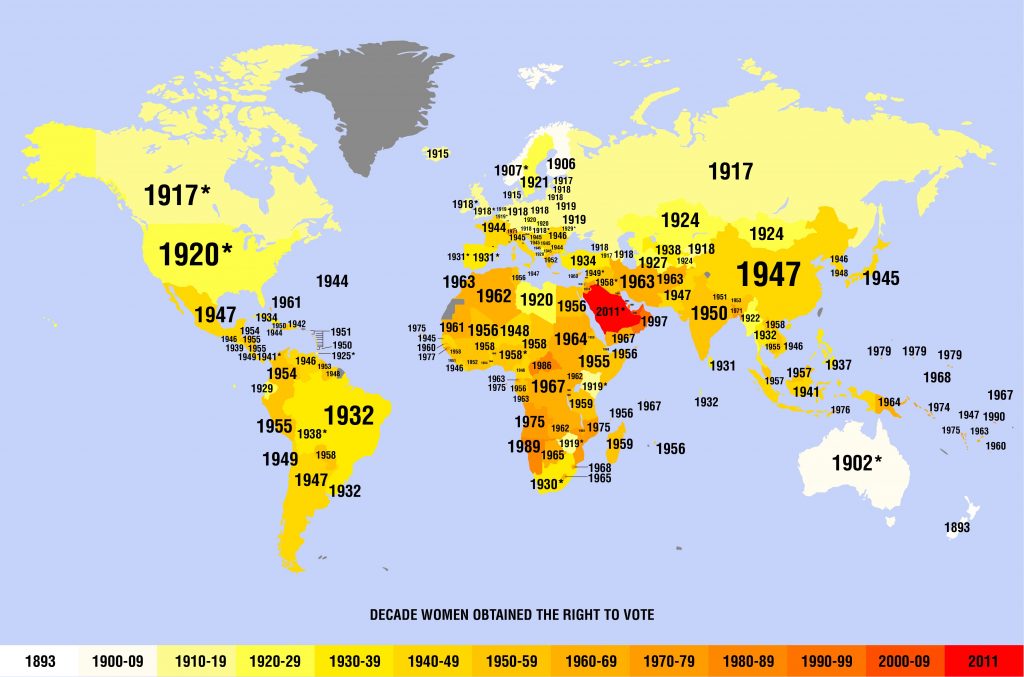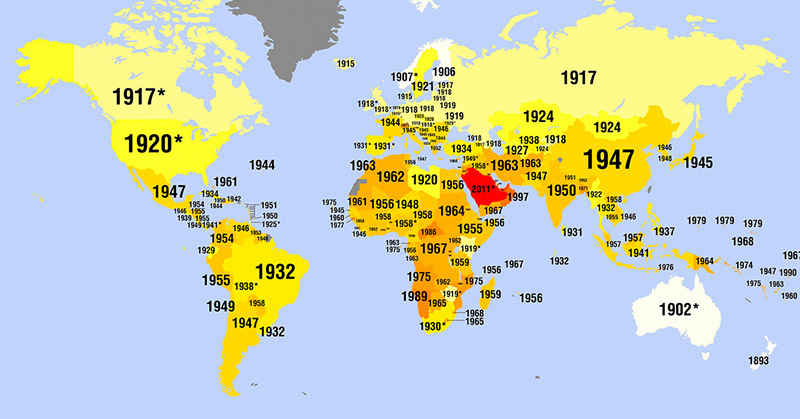Let’s be honest: Women were not given an easy lot in life. Often before we’re even teenagers we have to learn to cope with painful periods, accompanied by massive changes in the structure and function of our bodies. We sacrifice our bodies and temporarily our careers to have a child, spend years dealing with wildly fluctuating hormones, only to have it all change again when it’s time for menopause. To top it all off, we are faced with unrealistic expectations on how we should look, think, feel, and act.
Over hundreds of years and still today, women have had to fight for everything that we have. We have to fight to be taken seriously, to be heard, and to be given the same rights and opportunities as men.
Nothing highlights this more prominently than the suffrage movement that granted women the right to vote. What many of us may not realize, however, that this historic moment is not the same in every country, nor is it the same within each country for all women.

When Women Could Vote Around the World
Receiving the right to vote was an incredible step forward for women around the world, no matter what year they earned it in. It symbolizes the beginning of the realization that women, in fact, are whole persons who are highly intelligent and have good ideas (to say the least).
There it is again, though: earned. Women had to earn that right and prove to men that they were worthy of it. Women have been fighting to earn things and prove themselves to men ever since.
The first country to allow women to vote was New Zealand in 1893 and the latest was Saudia Arabia 118 years later in 2011. The United States passed the law in 1920. (1)
Not all women
The important thing to note is that in many of these countries, the new law did not apply to all women. There on asterisks on many of them for a variety of reasons:(1)
- Being a person of color or an aboriginal (both men and women)
- Owning property or related to income
- Having to be a part of the army or being closely related to a soldier
- Having to be the widow or mother of a soldier killed in battle or male citizen killed by the enemy, or having been a political prisoner by the enemy herself
- Being of a certain age
- Having a specified education level
In some countries, such as Spain and Kuwait, women lost the right to vote for a period of time after it was granted depending on who was in power. In the case of Iraq, women won the right to vote in 1958, but before they had the chance to exercise that right the government was overthrown. It was another 22 years before they won it back. (1)
It is important to note that in nearly every country where multiple ethnicities of people live, white women were always given the vote before any race. It was anywhere from 30 to 60 years after that before Indigenous or Black women were allowed to vote, depending on the country. (1)
Read: A 1970 Law Led to the Mass Sterilization of Native American Women. That History Still Matters
What this means today
The timeline of women earning the right to vote, and those that those first laws excluded, shows us how much women have had to go through even to just get where we are today. Unfortunately, there is still a long way to go. There is still a wage gap between men and women in many professions. There is still a lack of representation of women, and especially non-white women, in leadership and government. There are still harmful stereotypes being used to describe women of color. There are still horrendous injustices happening to Indigenous women that are being overlooked because they are not white.
So what can we do about this?
For starters, if you’re a woman, you can stand up for yourself. When told a salary for a position, demand what you are worth. Take that major, apply for that job, and don’t let yourself feel inferior. Raise other women up instead of tearing them down. Work together and celebrate each others’ successes.
If you are a man, please, check your biases. Listen. Learn to take a back seat and let a woman take charge. Believe in the women in your life and cheer them on. Encourage your daughters, sisters, mothers, and female friends to take on challenges.
Women (note: all women) are smart, strong, and capable. They can lead. The more we start believing and investing in women, the better our world will become.
Keep Reading: Sometimes a Day Off with the Kids is Harder Than a Work Day

